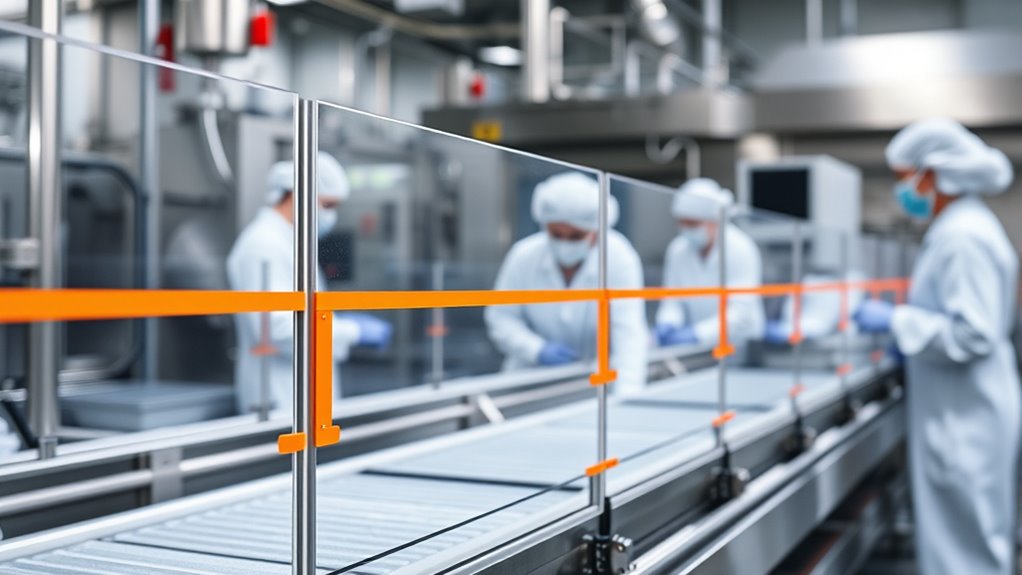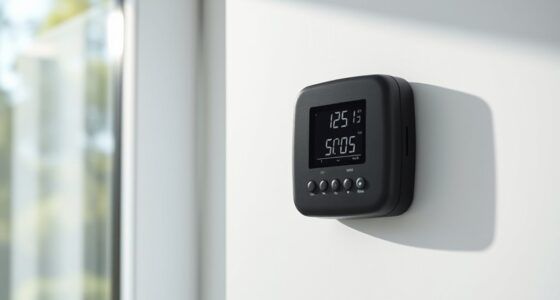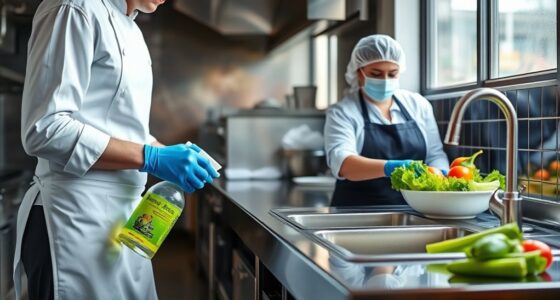Cross-contamination barriers on the line include physical walls, enclosures, conveyor shields, and airflow systems, all made from food-grade materials like stainless steel and plastics that are easy to clean. Designing effective barriers involves creating segregated zones, visual cues, and easy-to-maintain surfaces. Proper cleaning, staff training, and regular monitoring ensure these barriers stay effective. If you want to learn how to implement and maintain these barriers properly, here’s more detailed guidance to help you succeed.
Key Takeaways
- Cross-contamination barriers include physical walls, enclosures, and airflow systems to separate raw and cooked products.
- Materials like food-grade plastics and stainless steel ensure durability, ease of cleaning, and hygiene compliance.
- Proper design and segregation strategies involve visual cues, color-coding, and regular enclosure integrity checks.
- Staff training emphasizes correct handling, inspection, cleaning, and immediate replacement of damaged barriers.
- Technological solutions such as monitoring systems and UV sterilization enhance barrier effectiveness and contamination control.
Types of Cross-Contamination Barriers in Food Processing
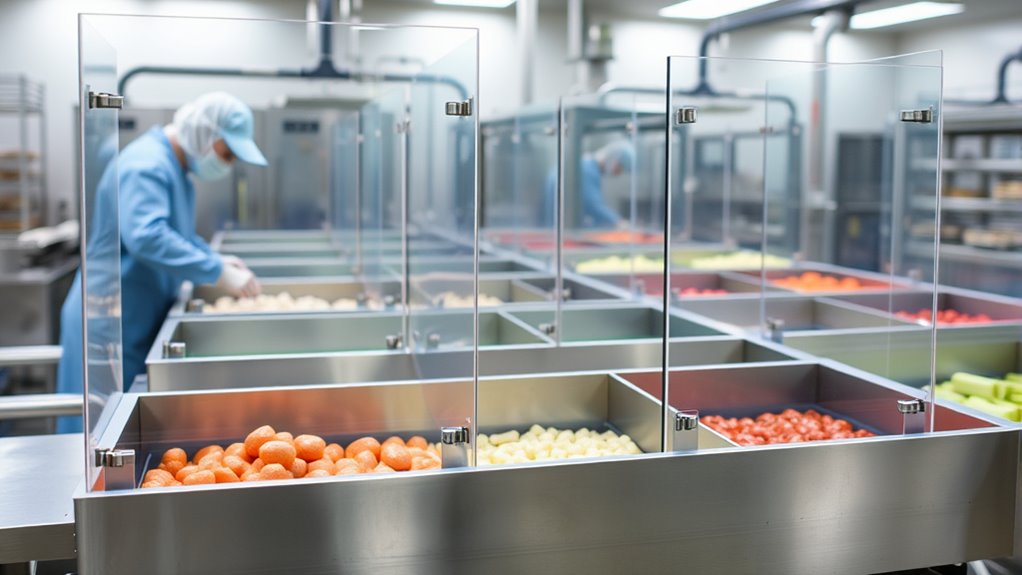
Have you ever wondered how food processing facilities prevent cross-contamination? One key method is using different types of barriers tailored to specific needs. Physical barriers, like walls and partitions, create clear boundaries between raw and cooked products. Enclosed processing zones help contain contaminants and limit exposure. Protective barriers, such as conveyor shields and covers, prevent direct contact with equipment or surfaces. Additionally, color-coded zones and designated pathways act as visual cues, guiding workers and minimizing accidental cross-over. Some facilities employ air curtains or controlled airflow systems to block airborne contaminants. Properly designing and maintaining these barriers is crucial for effective contamination control, ensuring that cross-contamination risks stay minimized. Each barrier type plays a crucial role in maintaining hygiene and safety, ensuring that cross-contamination risks stay minimized. Properly selecting and implementing these barriers is essential for achieving a safe, compliant food processing environment.
Materials Used for Effective Barrier Implementation
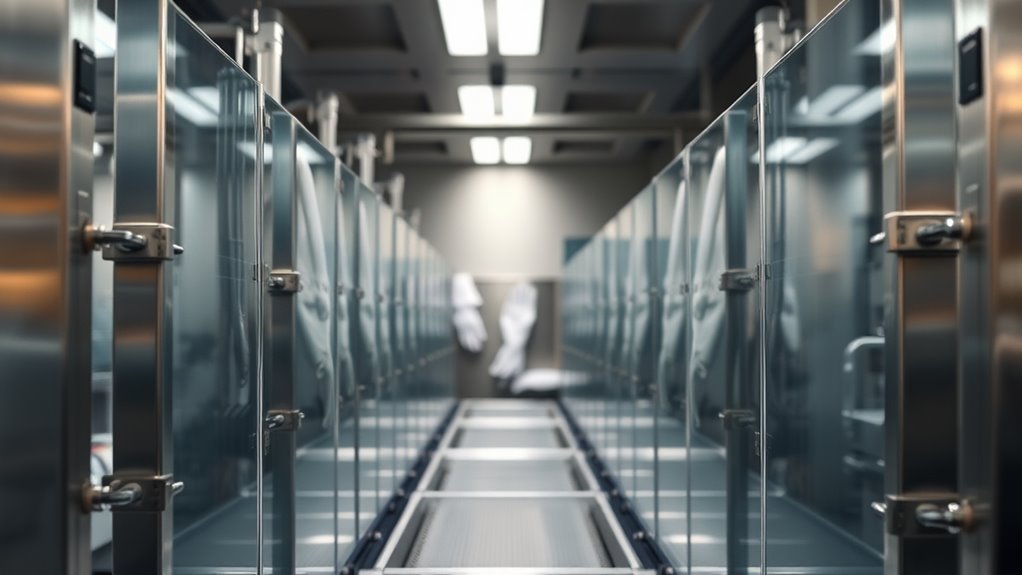
Selecting the right materials for barriers is critical to ensuring effective containment and hygiene in food processing. You need durable, easy-to-clean materials that prevent contamination and withstand regular sanitation. Food-grade plastics, such as polyethylene and polypropylene, are popular because they’re lightweight and resistant to chemicals. Stainless steel is another excellent option, offering strength, longevity, and corrosion resistance. Additionally, rubber and silicone seals help maintain airtight barriers, preventing microbial transfer. Consider the following when choosing materials: compatibility with cleaning agents and disinfectants, resistance to wear, tear, and impact, ease of sterilization and maintenance, and non-porous surfaces to prevent bacteria buildup.
Design Considerations for Barrier Systems
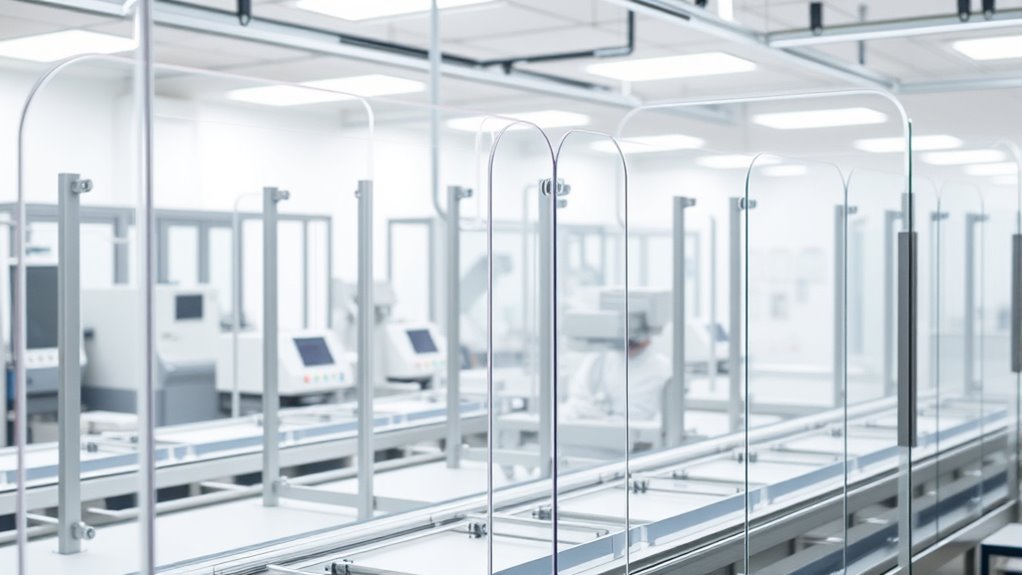
Effective barrier system design hinges on understanding how layout, accessibility, and material integration influence contamination control. You should optimize the workspace to minimize cross-contact points and ensure smooth movement of personnel and materials. Accessibility is vital; barriers must allow easy cleaning and quick adjustments without compromising integrity. Material choices impact durability and compatibility, so select surfaces resistant to cleaning agents and wear. Consider these key factors:
| Factor | Goal | Example |
|---|---|---|
| Layout | Reduce contamination risk | Proper spacing between zones |
| Accessibility | Ease of cleaning and use | Doors and panels designed for hygiene |
| Material | Durability and compatibility | Non-porous, corrosion-resistant surfaces |
Prioritize these considerations to create effective, adaptable barrier systems. Incorporating personnel training on proper barrier handling can further enhance contamination prevention.
Role of Enclosures and Segregation Areas
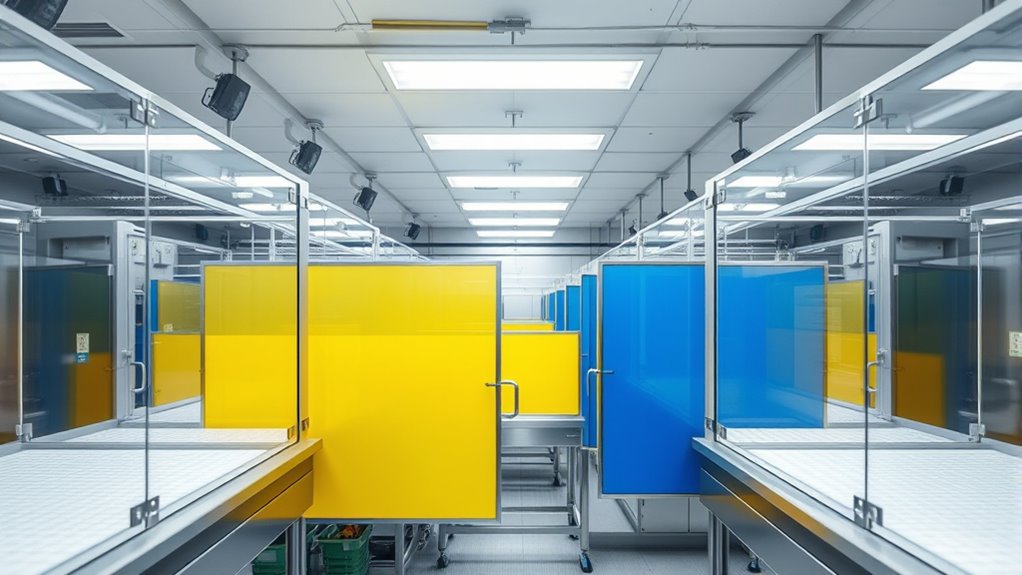
Enclosures and segregation areas are key to preventing cross-contamination, but their effectiveness depends on thoughtful design. You should focus on enclosure strategies that minimize airflow disruptions and contamination transfer. Properly implemented zones help contain hazards and protect clean areas from potential risks. Embracing creative practice principles can also inspire innovative solutions for enclosure design and layout.
Enclosure Design Strategies
Designing effective enclosures and segregation areas is critical for minimizing cross-contamination in food production environments. You want to create barriers that prevent pathogens from spreading between zones. Consider these strategies:
- Use physical barriers like walls, doors, and curtains to separate different production areas.
- Ensure enclosures are made from easy-to-clean, non-porous materials to reduce microbial buildup.
- Design airflow systems that direct contaminated air away from clean zones.
- Incorporate clear signage and visual cues to reinforce segregation protocols.
- Selecting appropriate materials can significantly improve the durability and hygiene of enclosures, reducing microbial contamination risks.
Segregation Zone Effectiveness
Implementing well-constructed enclosures and segregation areas is crucial for maintaining food safety by preventing cross-contamination. These zones act as physical barriers, limiting the movement of contaminants between different product types or process stages. Properly designed segregation areas ensure that raw, cooked, and ready-to-eat items stay separated, reducing the risk of bacteria transfer. You should evaluate enclosure integrity regularly, checking for gaps, leaks, or breaches that could compromise effectiveness. Clear signage and strict access controls help enforce segregation protocols. Additionally, staff training is indispensable to ensure everyone understands zone boundaries and procedures. When enclosures and segregation areas are effectively maintained, you create a controlled environment that minimizes cross-contact, safeguarding product quality and consumer health.
Use of Color-Coding and Labeling to Prevent Mix-Ups
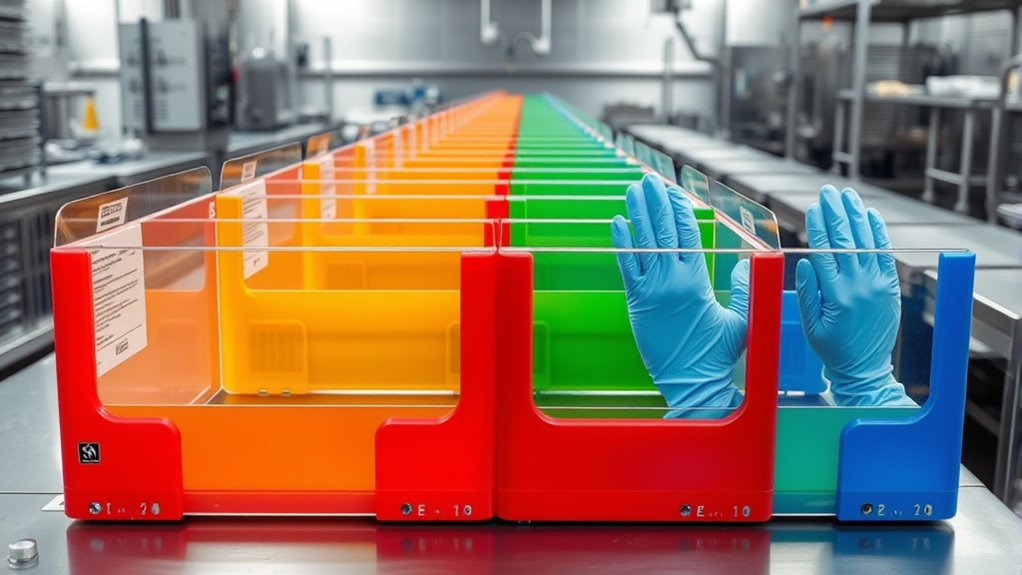
Using color-coding and labeling is an effective way to prevent cross-contamination by clearly distinguishing between different types of materials or areas. It helps you quickly identify and separate raw ingredients, cooked foods, allergens, and cleaning supplies. Proper implementation reduces mix-ups, saves time, and enhances safety on the line. To maximize effectiveness:
- Assign specific colors to different food groups or zones
- Use consistent labeling for containers and equipment
- Incorporate clear, legible text and symbols
- Regularly update labels to reflect changes or new items
This system minimizes errors, streamlines workflow, and reinforces hygiene practices. When everyone follows the color and label standards, you create a visual barrier that keeps cross-contamination risks low, ensuring food safety and compliance.
Personal Hygiene and Protective Equipment Standards
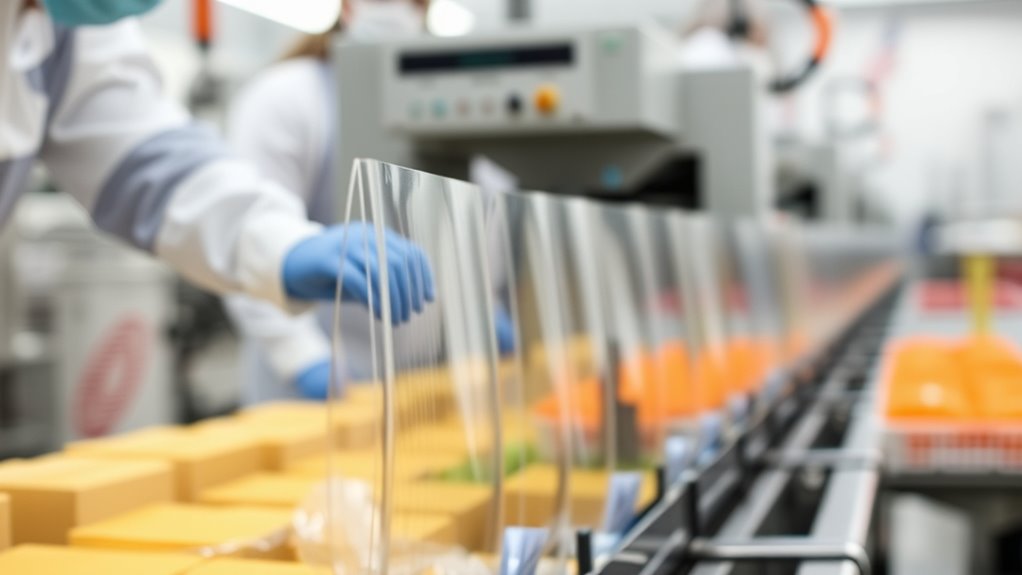
Have you ever considered how essential personal hygiene and protective equipment are in preventing cross-contamination? Maintaining clean hands, proper glove use, and suitable clothing are vital. You should wash your hands thoroughly before starting your shift, after touching raw ingredients, or after any interruption. Wearing gloves correctly and changing them regularly prevents bacteria transfer. Protective gear like aprons, hairnets, and masks create barriers between contaminants and food. Avoid touching your face or adjusting equipment without sanitizing your hands first. Personal hygiene isn’t just about cleanliness; it’s about consistently following protocols to ensure safety. Proper food safety practices include maintaining these standards diligently. By adhering strictly to these standards, you minimize the risk of bacteria spreading and keep the production environment safe for everyone. Your diligence makes a significant difference in maintaining a contamination-free line.
Cleaning and Sanitization Protocols for Barriers
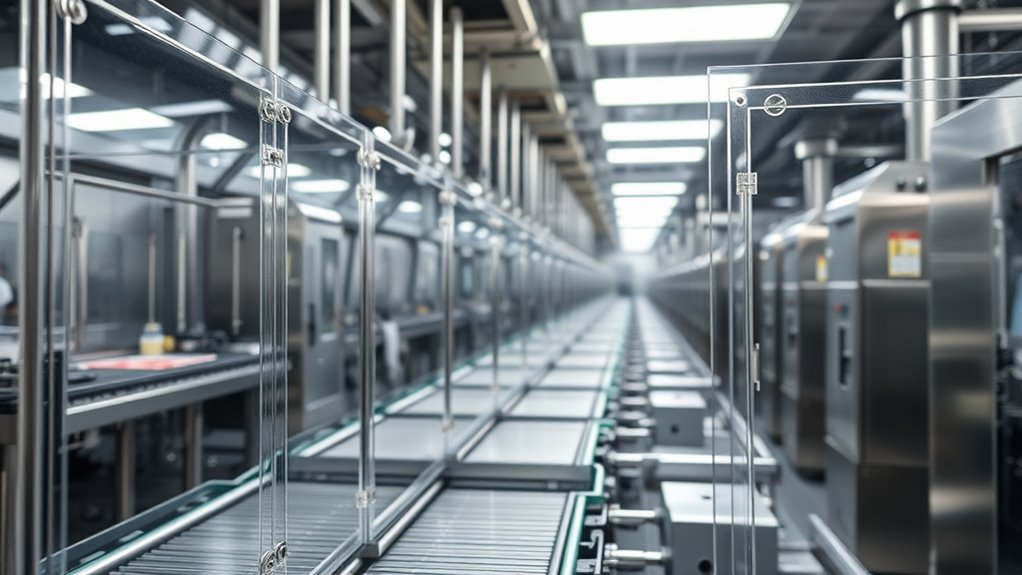
Since barriers like surfaces, equipment, and protective gear can harbor bacteria, establishing effective cleaning and sanitization protocols is essential. You need clear procedures to prevent cross-contamination and ensure safety. First, regularly clean surfaces with approved detergents to remove dirt and organic matter. Then, disinfect using EPA-registered sanitizers proven effective against pathogens. Ensure you follow manufacturer instructions for contact time and dilution. Additionally, keep a cleaning schedule and record each session to maintain consistency. Also, train staff on proper techniques to avoid missed spots or improper sanitization. Remember, routine inspection helps identify areas needing extra attention. By implementing these protocols, you reduce bacteria buildup, protect your team, and maintain a safe, hygienic environment. Effective sanitization is crucial in supporting a comprehensive hygiene program.
Technological Solutions Enhancing Barrier Effectiveness
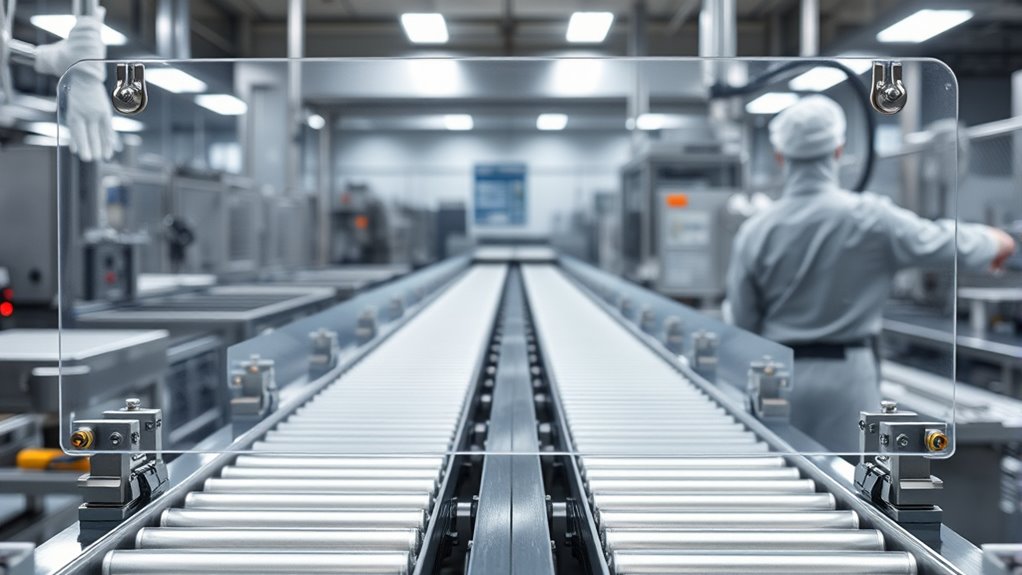
Advancements in technology have introduced innovative tools that markedly boost the effectiveness of barrier protocols. You can now utilize real-time monitoring systems that track barrier integrity automatically, alerting you to breaches instantly. UV-C sterilization devices are integrated into lines, continuously disinfecting surfaces and reducing manual cleaning needs. Advanced material sensors detect contamination levels, ensuring barriers remain effective and safe. Automated sealing and disinfection robots can quickly respond to potential breaches, maintaining continuous protection. Digital records of barrier status and maintenance are now accessible, helping you stay compliant and identify issues early. Preppy Dog Names These technological solutions streamline operations, reduce human error, and guarantee barriers perform at their best, ultimately enhancing food safety and minimizing cross-contamination risks on the line.
Training Staff on Barrier Usage and Maintenance

You need to make sure your staff knows how to handle barriers properly to prevent contamination. Regular training sessions help reinforce correct techniques and keep everyone up-to-date. When staff are well-trained, the barriers work effectively to protect both workers and products.
Proper Barrier Handling Techniques
Proper barrier handling is essential to prevent cross-contamination, and training staff effectively on their correct usage and maintenance is a critical step. When handling barriers, always inspect them for damage before use. Make sure you properly don and doff gloves and barriers to avoid contamination transfer. Regularly clean and disinfect barriers according to protocols, and store them in designated areas to prevent dirt or cross-contact. Be cautious to avoid touching the barrier’s exterior surfaces unnecessarily. If a barrier becomes torn or contaminated, replace it immediately. Remember, consistent handling practices are key. Additionally, understanding the effectiveness of hydrocolloid patches can inform proper treatment and maintenance of skin barriers, ensuring optimal protection and healing.
Regular Staff Training Sessions
How can staff consistently guarantee barriers are used and maintained correctly? Regular training sessions are essential. You should schedule frequent, focused workshops that cover proper barrier handling, cleaning protocols, and inspection procedures. During these sessions, you’ll learn to identify signs of wear or damage and understand the importance of strict adherence to maintenance routines. Reinforcing the correct application of barriers ensures your team remains vigilant and knowledgeable. Hands-on practice helps solidify these skills, reducing mistakes. Keep training materials updated with the latest guidelines and best practices. By investing in ongoing education, you empower staff to prevent cross-contamination effectively. Well-trained employees are your first line of defense, ensuring barriers function properly and maintain their integrity on the line.
Monitoring and Auditing Barrier Performance
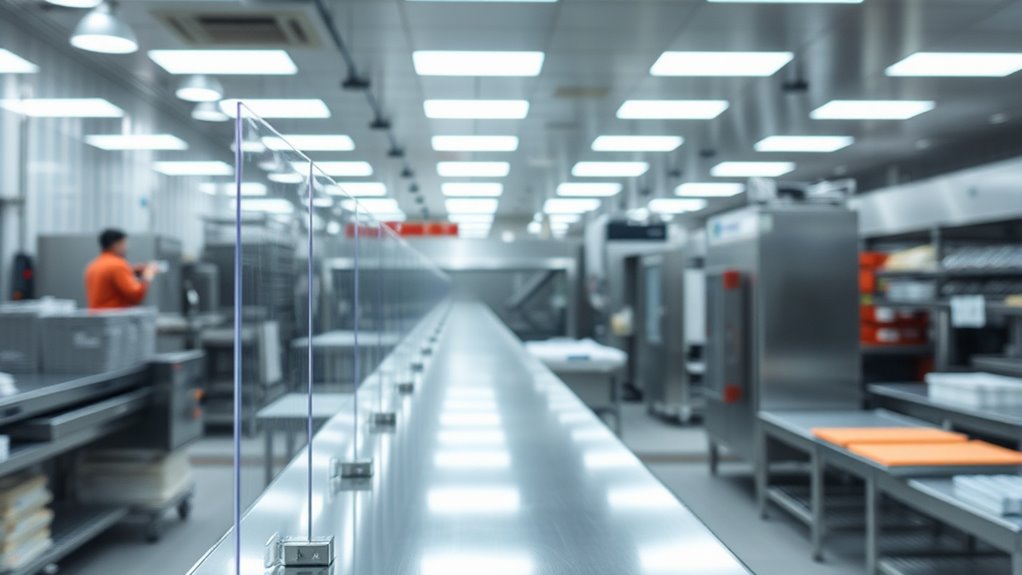
Effective monitoring and auditing are essential for guaranteeing that cross-contamination barriers function as intended. Regular checks help identify gaps before they become problems. You should implement consistent observation routines, review performance data, and document findings thoroughly. Use audits to verify staff adherence to protocols and barrier integrity. Keep an eye out for signs of wear, improper use, or breaches. Make certain corrective actions are taken promptly when issues arise. Regularly update your audit procedures to reflect new risks or changes in processes. Engage staff in audits to promote accountability and awareness. Use these insights to improve training and reinforce best practices. By staying vigilant, you prevent contamination risks and maintain a safe, compliant production environment. Incorporating regulatory standards into your auditing process ensures ongoing compliance and safety.
Frequently Asked Questions
How Often Should Cross-Contamination Barriers Be Inspected for Effectiveness?
You should inspect cross-contamination barriers regularly to guarantee they remain effective. Typically, it’s recommended to do daily inspections before shifts begin and periodically throughout the day, especially after cleaning or if you notice any damage. Consistent checks help identify tears, breaches, or wear that could compromise safety. By staying vigilant and maintaining proper inspection routines, you keep the barriers effective and protect your product and team from contamination risks.
Can Barriers Be Reused or Are They Single-Use Only?
You might wonder if barriers are reusable or single-use. Generally, it depends on the type of barrier and manufacturer guidelines. Some barriers are designed for multiple uses if cleaned and sanitized properly, while others are single-use to prevent contamination risks. Always follow your facility’s protocols and manufacturer instructions. Properly inspecting and maintaining barriers guarantees they remain effective, reducing cross-contamination and safeguarding food safety.
What Are the Costs Associated With Implementing Advanced Barrier Systems?
When considering advanced barrier systems, you need to evaluate the costs involved. These include initial expenses for purchasing and installing the barriers, along with ongoing costs like maintenance, cleaning, and potential replacements. While upfront costs may be higher than basic barriers, they can reduce contamination risks and improve safety. Overall, investing in advanced barriers can lead to long-term savings by preventing product recalls and ensuring compliance.
How Do Barriers Impact Overall Production Efficiency?
You might think barriers slow down production, but they actually boost efficiency by reducing contamination-related downtime. By keeping processes clean and minimizing cross-contact, you avoid shutdowns caused by contamination issues. This means smoother operations and less rework. Plus, barriers help maintain product quality, leading to fewer recalls and customer complaints. Overall, investing in barriers streamlines your production line, saving time and money while maintaining high safety standards.
Are There Specific Regulations Governing Barrier Standards Across Different Regions?
You should know that regulations vary across regions, and they set standards for barrier effectiveness, placement, and maintenance. In the US, the FDA and USDA provide guidelines, while Europe follows EFSA regulations. These standards aim to prevent contamination, ensuring safety and compliance. To stay compliant, you must regularly review regional regulations and implement barriers accordingly, adapting your practices to meet specific legal requirements in each region.
Conclusion
Think of cross-contamination barriers as the shield guarding your food’s integrity. By carefully choosing materials, designing thoughtful enclosures, and maintaining rigorous protocols, you become the sentinel protecting every ingredient. Proper barriers symbolize your commitment to safety, ensuring each step is a fortress against unseen threats. When you prioritize these measures, you uphold the trust your customers place in your products, turning everyday practices into a legacy of purity and care.
